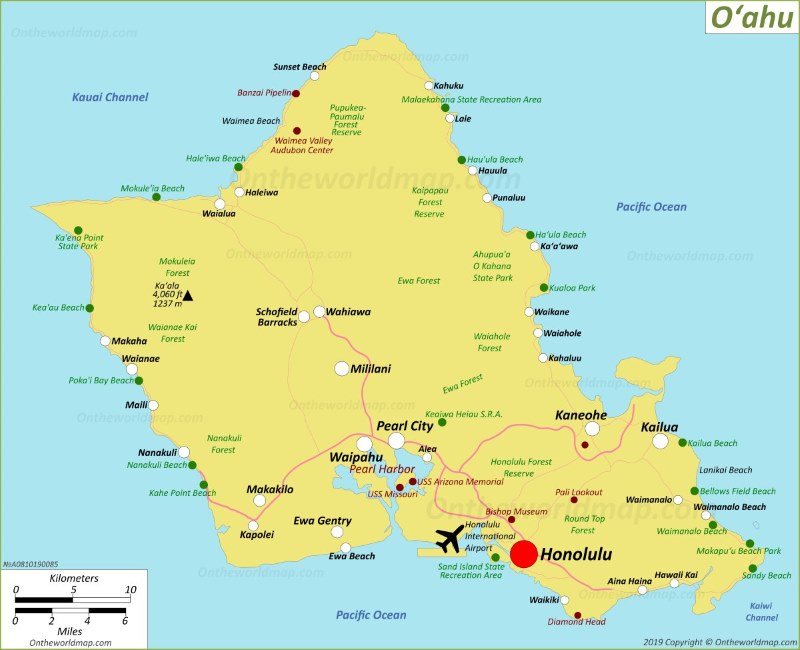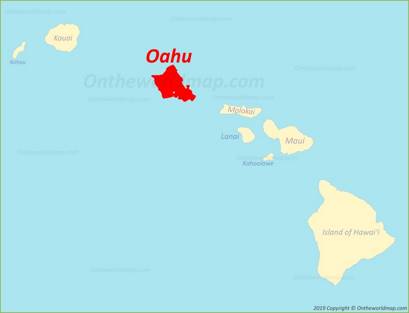Oahu Map
Description:
This map shows roads, airport, state capital, county seat, cities, towns, villages, beaches, parks, peaks, points of interest, and tourist attractions on Oahu Island.
Size: 1200x975px / 169 Kb
Author: Ontheworldmap.com
You may download, print or use the above map for educational, personal and non-commercial purposes. Attribution is required. For any website, blog, scientific research or e-book, you must place a hyperlink (to this page) with an attribution next to the image used.
Oahu Location Map
About Oahu
Oahu is the third largest Hawaiian island and the most populated of the islands in the U.S. state of Hawaii. With an area of 596.7 square miles (1,545 km²), it is home to roughly one million residents—approximately two-thirds of the population of the state. The island is nicknamed "The Gathering Place," reflecting its role as the economic and cultural center of Hawaii.
Geologically, Oahu was formed from two separate shield volcanoes: Waianae and Koolau, with the broad valley between them creating the fertile central plain. The highest point on the island is Mount Kaala in the Waianae Range, standing at 4,003 feet (1,220 meters) above sea level. The island features approximately 112 miles (180 km) of coastline and is bordered by the Kaiwi Channel on the east, the Kauai Channel on the west, and the Pacific Ocean to the north and south.
Honolulu, located on the southeast coast of the island, serves as both the capital of Hawaii and the county seat of the City and County of Honolulu, which encompasses the entire island. Other significant communities include Kailua, Kaneohe, Mililani, Pearl City, Waipahu, Kahuku, Kaaawa, and Waianae. The island is divided into several regions, including the North Shore, known for its massive winter waves and world-class surfing competitions; the Windward Coast (eastern side), characterized by lush, green mountains and beautiful beaches; the Leeward Coast (western side), which is drier and less developed; and Central Oahu, home to pineapple fields and military installations.
The climate on Oahu is tropical with relatively minor temperature variations throughout the year. Average daytime temperatures range from 70°F to 85°F (21°C to 29°C), while the ocean temperature averages 74°F to 80°F (23°C to 27°C). The island experiences two main seasons: the dry season from April to October and the rainy season from November to March. Rainfall varies significantly across the island due to the mountain ranges, with the windward (northeastern) side receiving considerably more precipitation than the leeward (southwestern) side.
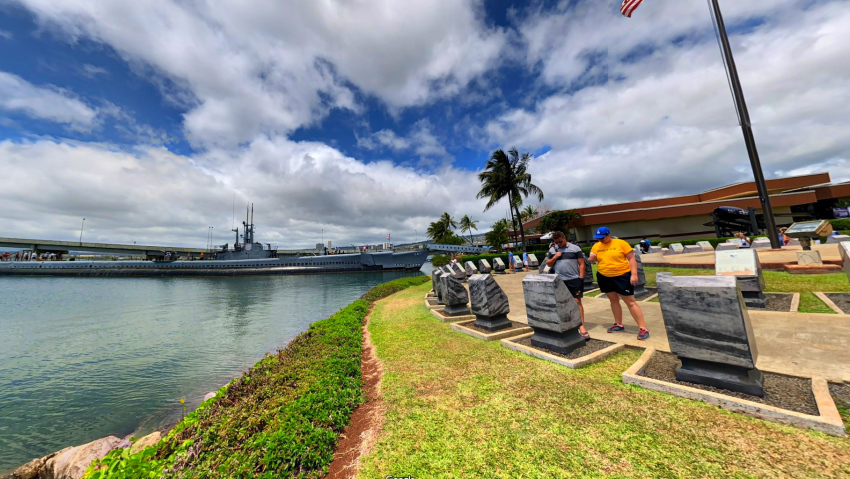
Oahu is home to numerous historical and cultural landmarks. Pearl Harbor, site of the December 7, 1941 attack that propelled the United States into World War II, contains several memorials including the USS Arizona Memorial. Iolani Palace, the only royal palace on U.S. soil, served as the official residence of the Hawaiian Kingdom's last monarchs. Other significant sites include Diamond Head (Leahi), an extinct volcanic crater and iconic landmark; Nuuanu Pali Lookout, offering panoramic views of the windward coast; and the Polynesian Cultural Center, which showcases the cultures of Polynesia.
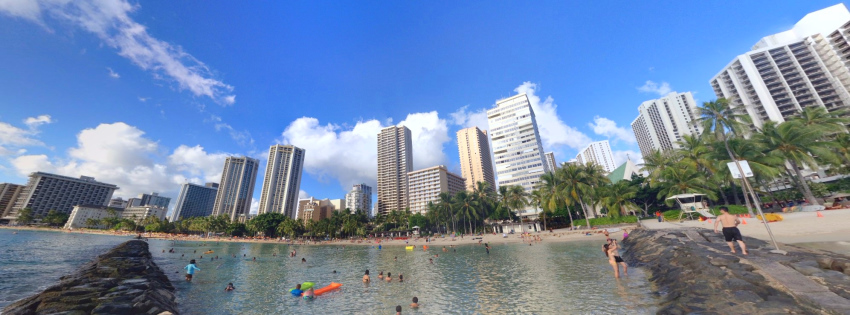
The island features some of Hawaii's most famous beaches, including Waikiki Beach, a world-renowned tourist destination; Lanikai Beach, consistently ranked among the world's best beaches; Sunset Beach and Pipeline on the North Shore, famous for professional surfing competitions; Hanauma Bay, a protected marine life conservation area popular for snorkeling; and Kailua Beach, known for its turquoise waters and powdery white sand.
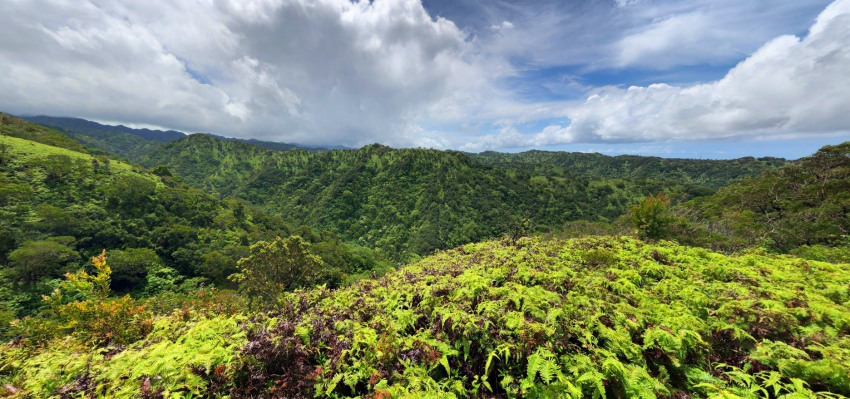
The economy of Oahu is primarily driven by tourism, military defense, and agriculture. The island hosts approximately 5.5 million visitors annually, who contribute significantly to the local economy. Military installations, including Joint Base Pearl Harbor-Hickam, Schofield Barracks, and Marine Corps Base Hawaii, employ thousands of military personnel and civilians. Although once dominated by sugar and pineapple plantations, agriculture on the island now focuses on diversified crops and supports a growing farm-to-table movement.
The Facts:| State: | Hawaii |
| Largest settlement: | Honolulu |
| County: | Honolulu |
| Population (2020): | 1,016,508[1] |
| Density: | 1,704/sq mi (657.9/sq km) |
| Area: | 596.7 sq mi (1,545 sq km) |
| Coordinates: | 21.5°N 158.0°W |
| Highest elevation: | Kaʻala - 4,025 ft (1226.8 m) |
List of Cities and Towns on Oahu
- Hickam Housing
- Waikele
- Waimanalo
- Laie
- Waipio Acres
- West Loch Estate
- Kahaluu
- Pupukea
- Heeia
- Haleiwa
- Whitmore Village
- Waimanalo Beach
- Iroquois Point
- Waialua
- Hauula
- Kahuku
- Wheeler AFB
- Kalaeloa
- Maunawili
- Ko Olina
- Mokuleia
- Kaaawa
- Punaluu
- Waikane
- Kawela Bay
- Makaha Valley
20 Best Beaches on Oahu
- Waikiki Beach
- Lanikai Beach
- Kailua Beach
- Sunset Beach
- Waimea Bay
- Hanauma Bay
- Ko Olina Lagoons
- Ala Moana Beach Park
- Makapuu Beach
- Sandy Beach
- Yokohama Bay
- Kahana Bay Beach Park
- Bellows Beach
- Turtle Bay
- Haleiwa Beach Park
- Kahe Point Beach Park (Electric Beach)
- Makaha Beach
- Malaekahana Beach
- Kualoa Regional Park
- Pokai Bay
Main sights on Oahu
- Diamond Head State Monument
- Pearl Harbor National Memorial
- Polynesian Cultural Center
- Dole Plantation
- Waikiki Beach
- North Shore
- Hanauma Bay Nature Preserve
- Kualoa Ranch
- Iolani Palace
- Nuuanu Pali Lookout
- Bishop Museum
- Waimea Valley
- Halona Blowhole
- Byodo-In Temple
- Makapuu Lighthouse Trail
- Honolulu Museum of Art
- Ala Moana Center
- Manoa Falls
- Ko Olina Lagoons
- Laniakea Beach (Turtle Beach)
References
1. ^ U.S. Census Bureau.U.S. Maps
Maps of Hawaii

